Abstract
The aminophospholipids of microvesicles released from human erythrocytes on storage or prepared from erythrocyte ghosts by shearing under pressure are susceptible to the action of 2,4,6-trinitrobenzenesulphonic acid. The aminophospholipids of the former vesicles are also susceptible to attack by phospholipase A2. Under the same conditions, the aminophospholipids of erythrocytes undergo little reaction. This suggests that the phospholipids in microvesicle membranes are more randomly distributed than those in erythrocyte membranes. Measurements have also been made of the ability of filipin to react with the cholesterol of sealed and unsealed erythrocyte ghosts and of microvesicles prepared from them. From the initial rates of reaction, it was concluded that there is no preferential transfer of cholesterol molecules from one side of the bilayer to the other during the formation of the microvesicles.
Full text
PDF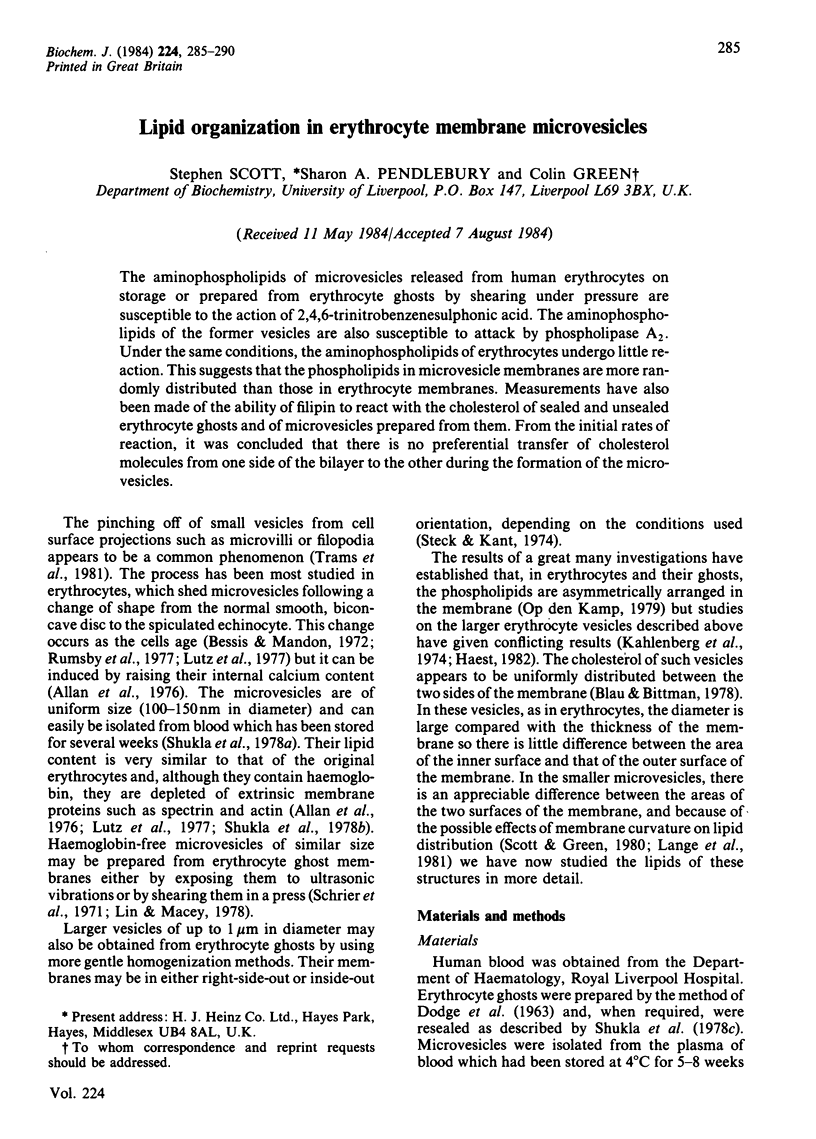
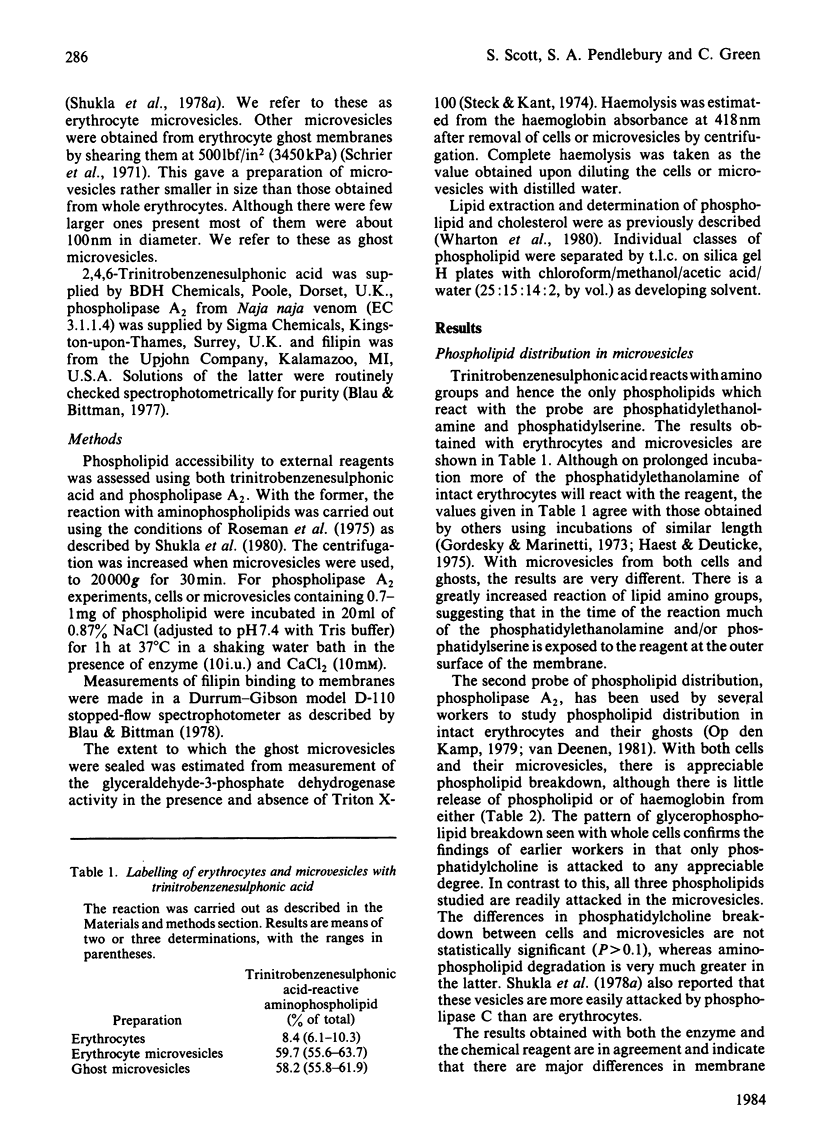
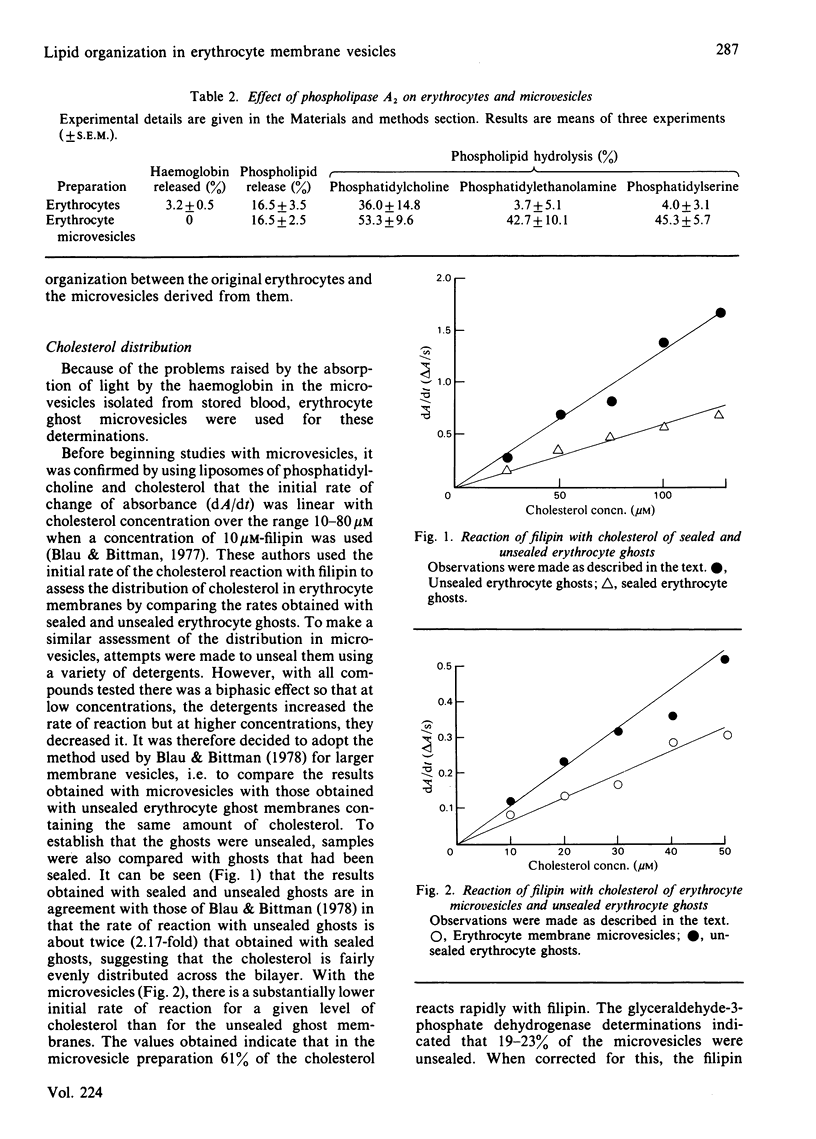
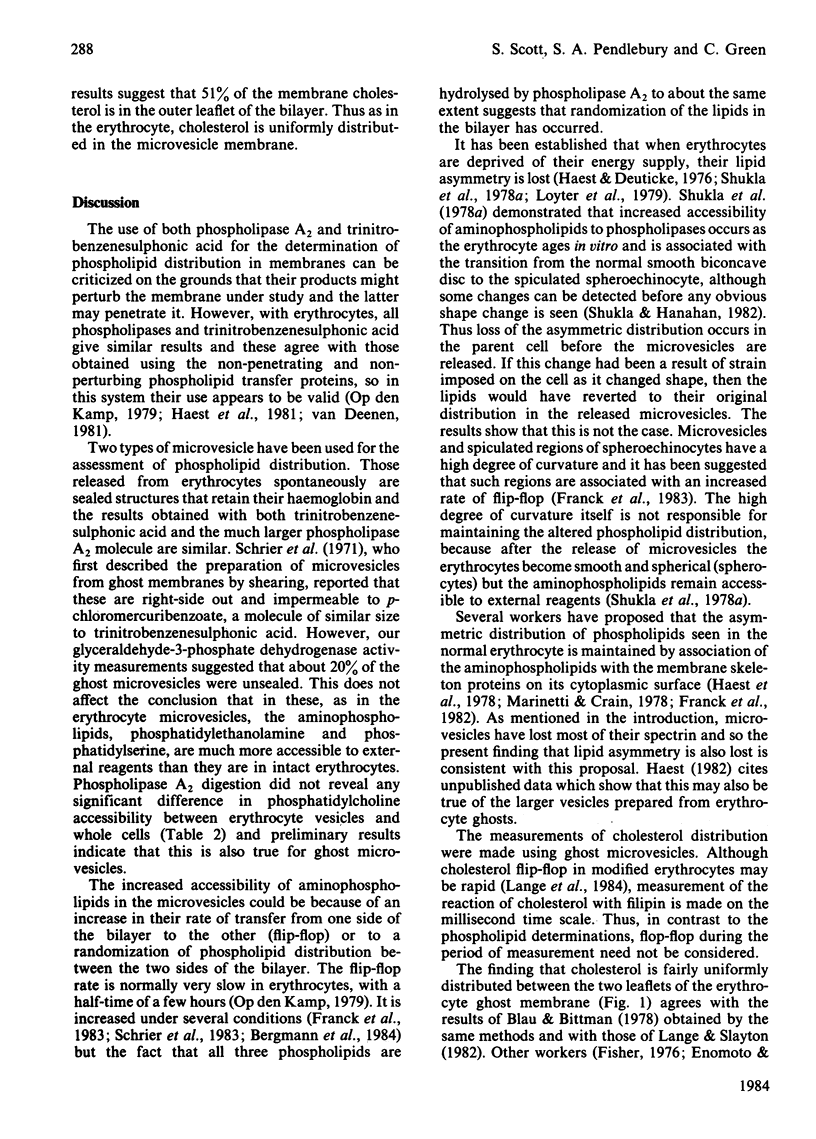
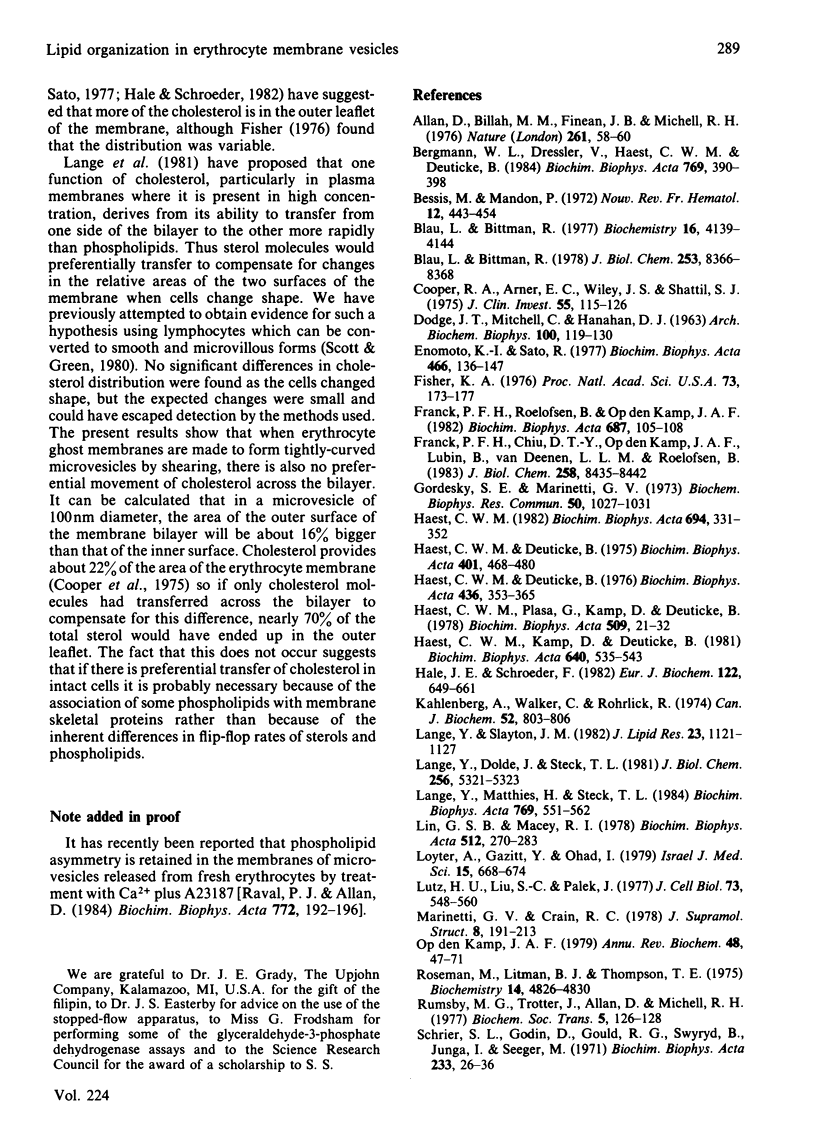

Selected References
These references are in PubMed. This may not be the complete list of references from this article.
- Allan D., Billah M. M., Finean J. B., Michell R. H. Release of diacylglycerol-enriched vesicles from erythrocytes with increased intracellular (Ca2+). Nature. 1976 May 6;261(5555):58–60. doi: 10.1038/261058a0. [DOI] [PubMed] [Google Scholar]
- Bergmann W. L., Dressler V., Haest C. W., Deuticke B. Cross-linking of SH-groups in the erythrocyte membrane enhances transbilayer reorientation of phospholipids. Evidence for a limited access of phospholipids to the reorientation sites. Biochim Biophys Acta. 1984 Jan 25;769(2):390–398. doi: 10.1016/0005-2736(84)90322-5. [DOI] [PubMed] [Google Scholar]
- Bessis M., Mandon P. La microsphérulation et les formes myéliniques des globules rouges. Examen comparé au microscope électronique à balayage et à transmission. Nouv Rev Fr Hematol. 1972 Jul-Aug;12(4):443–454. [PubMed] [Google Scholar]
- Blau L., Bittman R. Cholesterol distribution between the two halves of the lipid bilayer of human erythrocyte ghost membranes. J Biol Chem. 1978 Dec 10;253(23):8366–8368. [PubMed] [Google Scholar]
- Blau L., Bittman R. Interaction of filipin with cholesterol in vesicles of saturated phospholipids. Biochemistry. 1977 Sep 20;16(19):4139–4144. doi: 10.1021/bi00638a001. [DOI] [PubMed] [Google Scholar]
- Cooper R. A., Arner E. C., Wiley J. S., Shattil S. J. Modification of red cell membrane structure by cholesterol-rich lipid dispersions. A model for the primary spur cell defect. J Clin Invest. 1975 Jan;55(1):115–126. doi: 10.1172/JCI107901. [DOI] [PMC free article] [PubMed] [Google Scholar]
- DODGE J. T., MITCHELL C., HANAHAN D. J. The preparation and chemical characteristics of hemoglobin-free ghosts of human erythrocytes. Arch Biochem Biophys. 1963 Jan;100:119–130. doi: 10.1016/0003-9861(63)90042-0. [DOI] [PubMed] [Google Scholar]
- Enomoto K. I., Sato R. Asymmetric binding of cytochrome b5 to the membrane of human erythrocyte ghosts. Biochim Biophys Acta. 1977 Apr 1;466(1):136–147. doi: 10.1016/0005-2736(77)90214-0. [DOI] [PubMed] [Google Scholar]
- Fisher K. A. Analysis of membrane halves: cholesterol. Proc Natl Acad Sci U S A. 1976 Jan;73(1):173–177. doi: 10.1073/pnas.73.1.173. [DOI] [PMC free article] [PubMed] [Google Scholar]
- Franck P. F., Chiu D. T., Op den Kamp J. A., Lubin B., van Deenen L. L., Roelofsen B. Accelerated transbilayer movement of phosphatidylcholine in sickled erythrocytes. A reversible process. J Biol Chem. 1983 Jul 10;258(13):8436–8442. [PubMed] [Google Scholar]
- Franck P. F., Roelofsen B., Op den Kamp J. A. Complete exchange of phosphatidylcholine from intact erythrocytes after protein crosslinking. Biochim Biophys Acta. 1982 Apr 23;687(1):105–108. doi: 10.1016/0005-2736(82)90176-6. [DOI] [PubMed] [Google Scholar]
- Gordesky S. E., Marinetti G. V. The asymetric arrangement of phospholipids in the human erythrocyte membrane. Biochem Biophys Res Commun. 1973 Feb 20;50(4):1027–1031. doi: 10.1016/0006-291x(73)91509-x. [DOI] [PubMed] [Google Scholar]
- Haest C. W., Deuticke B. Experimental alteration of phospholipid-protein interactions within the human erythrocyte membrane. Dependence on glycolytic metabolism. Biochim Biophys Acta. 1975 Sep 2;401(3):468–480. doi: 10.1016/0005-2736(75)90244-8. [DOI] [PubMed] [Google Scholar]
- Haest C. W., Deuticke B. Possible relationship between membrane proteins and phospholipid asymmetry in the human erythrocyte membrane. Biochim Biophys Acta. 1976 Jun 17;436(2):353–365. doi: 10.1016/0005-2736(76)90199-1. [DOI] [PubMed] [Google Scholar]
- Haest C. W. Interactions between membrane skeleton proteins and the intrinsic domain of the erythrocyte membrane. Biochim Biophys Acta. 1982 Dec;694(4):331–352. doi: 10.1016/0304-4157(82)90001-6. [DOI] [PubMed] [Google Scholar]
- Haest C. W., Kamp D., Deuticke B. Penetration of 2,4,5-trinitrobenzenesulfonate into human erythrocytes. Consequences for studies on phospholipid asymmetry. Biochim Biophys Acta. 1981 Jan 22;640(2):535–543. doi: 10.1016/0005-2736(81)90477-6. [DOI] [PubMed] [Google Scholar]
- Haest C. W., Plasa G., Kamp D., Deuticke B. Spectrin as a stabilizer of the phospholipid asymmetry in the human erythrocyte membrane. Biochim Biophys Acta. 1978 May 4;509(1):21–32. doi: 10.1016/0005-2736(78)90004-4. [DOI] [PubMed] [Google Scholar]
- Hale J. E., Schroeder F. Asymmetric transbilayer distribution of sterol across plasma membranes determined by fluorescence quenching of dehydroergosterol. Eur J Biochem. 1982 Mar 1;122(3):649–661. doi: 10.1111/j.1432-1033.1982.tb06488.x. [DOI] [PubMed] [Google Scholar]
- Kahlenberg A., Walker C., Rohrlick R. Evidence for an asymmetric distribution of phospholipids in the human erythrocyte membrane. Can J Biochem. 1974 Sep;52(9):803–806. doi: 10.1139/o74-114. [DOI] [PubMed] [Google Scholar]
- Lange Y., Dolde J., Steck T. L. The rate of transmembrane movement of cholesterol in the human erythrocyte. J Biol Chem. 1981 Jun 10;256(11):5321–5323. [PubMed] [Google Scholar]
- Lange Y., Matthies H., Steck T. L. Cholesterol oxidase susceptibility of the red cell membrane. Biochim Biophys Acta. 1984 Feb 15;769(3):551–562. doi: 10.1016/0005-2736(84)90053-1. [DOI] [PubMed] [Google Scholar]
- Lange Y., Slayton J. M. Interaction of cholesterol and lysophosphatidylcholine in determining red cell shape. J Lipid Res. 1982 Nov;23(8):1121–1127. [PubMed] [Google Scholar]
- Lin G. S., Macey R. I. Shape and stability changes in human erythrocyte membranes induced by metal cations. Biochim Biophys Acta. 1978 Sep 22;512(2):270–283. doi: 10.1016/0005-2736(78)90252-3. [DOI] [PubMed] [Google Scholar]
- Loyter A., Gazitt Y., Ohad I. Use of enzymatic and electron microscopy (freeze-etching) methods for studying ATP-dependent masking of erythrocyte membrane phospholipids. Isr J Med Sci. 1979 Aug;15(8):668–674. [PubMed] [Google Scholar]
- Lutz H. U., Liu S. C., Palek J. Release of spectrin-free vesicles from human erythrocytes during ATP depletion. I. Characterization of spectrin-free vesicles. J Cell Biol. 1977 Jun;73(3):548–560. doi: 10.1083/jcb.73.3.548. [DOI] [PMC free article] [PubMed] [Google Scholar]
- Op den Kamp J. A. Lipid asymmetry in membranes. Annu Rev Biochem. 1979;48:47–71. doi: 10.1146/annurev.bi.48.070179.000403. [DOI] [PubMed] [Google Scholar]
- Raval P. J., Allan D. Phospholipid asymmetry in the membranes of intact human erythrocytes and in spectrin-free microvesicles derived from them. Biochim Biophys Acta. 1984 May 16;772(2):192–196. doi: 10.1016/0005-2736(84)90043-9. [DOI] [PubMed] [Google Scholar]
- Roseman M., Litman B. J., Thompson T. E. Transbilayer exchange of phosphatidylethanolamine for phosphatidylcholine and N-acetimidoylphosphatidylethanolamine in single-walled bilayer vesicles. Biochemistry. 1975 Nov 4;14(22):4826–4830. doi: 10.1021/bi00693a008. [DOI] [PubMed] [Google Scholar]
- Rumsby M. G., Trotter J., Allan D., Michell R. H. Recovery of membrane micro-vesicles from human erythrocytes stored for transfusion: a mechanism for the erythrocyte discocyte-to-spherocyte shape transformation. Biochem Soc Trans. 1977;5(1):126–128. doi: 10.1042/bst0050126. [DOI] [PubMed] [Google Scholar]
- Schrier S. L., Chiu D. T., Yee M., Sizer K., Lubin B. Alteration of membrane phospholipid bilayer organization in human erythrocytes during drug-induced endocytosis. J Clin Invest. 1983 Nov;72(5):1698–1705. doi: 10.1172/JCI111129. [DOI] [PMC free article] [PubMed] [Google Scholar]
- Schrier S. L., Godin D., Gould R. G., Swyryd B., Junga I., Seeger M. Characterization of microvesicles produced by shearing of human erythrocyte membranes. Biochim Biophys Acta. 1971 Mar 9;233(1):26–36. doi: 10.1016/0005-2736(71)90354-3. [DOI] [PubMed] [Google Scholar]
- Shukla S. D., Berriman J., Coleman R., Finean J. B., Michell R. H. Membrane protein segregation during release of microvesicles from human erythrocytes. FEBS Lett. 1978 Jun 15;90(2):289–292. doi: 10.1016/0014-5793(78)80388-3. [DOI] [PubMed] [Google Scholar]
- Shukla S. D., Billah M. M., Coleman R., Finean J. B., Michell R. H. Modulation of the organization of erythrocyte membrane phospholipids by cytoplasmic ATP. The susceptibility of isoionic human erythrocytes ghosts to attack by detergents and phospholipase C. Biochim Biophys Acta. 1978 May 4;509(1):48–57. doi: 10.1016/0005-2736(78)90006-8. [DOI] [PubMed] [Google Scholar]
- Shukla S. D., Coleman R., Finean J. B., Michell R. H. The use of phospholipase c to detect structural changes in the membranes of human erythrocytes aged by storage. Biochim Biophys Acta. 1978 Sep 22;512(2):341–349. doi: 10.1016/0005-2736(78)90258-4. [DOI] [PubMed] [Google Scholar]
- Shukla S. D., Green C., Turner J. M. Phosphatidylethanolamine distribution and fluidity in outer and inner membranes of the gram-negative bacterium Erwinia carotovora. Biochem J. 1980 Apr 15;188(1):131–135. doi: 10.1042/bj1880131. [DOI] [PMC free article] [PubMed] [Google Scholar]
- Shukla S. D., Hanahan D. J. Membrane alterations in cellular aging: susceptibility of phospholipids in density (age)-separated human erythrocytes to phospholipase A2. Arch Biochem Biophys. 1982 Mar;214(1):335–341. doi: 10.1016/0003-9861(82)90038-8. [DOI] [PubMed] [Google Scholar]
- Steck T. L., Kant J. A. Preparation of impermeable ghosts and inside-out vesicles from human erythrocyte membranes. Methods Enzymol. 1974;31:172–180. doi: 10.1016/0076-6879(74)31019-1. [DOI] [PubMed] [Google Scholar]
- Trams E. G., Lauter C. J., Salem N., Jr, Heine U. Exfoliation of membrane ecto-enzymes in the form of micro-vesicles. Biochim Biophys Acta. 1981 Jul 6;645(1):63–70. doi: 10.1016/0005-2736(81)90512-5. [DOI] [PubMed] [Google Scholar]
- Wharton S. A., De Martinez S. G., Green C. Use of fluorescent probes in the study of phospholipid--sterol bilayers. Biochem J. 1980 Dec 1;191(3):785–790. doi: 10.1042/bj1910785. [DOI] [PMC free article] [PubMed] [Google Scholar]
- van Deenen L. L. Topology and dynamics of phospholipids in membranes. FEBS Lett. 1981 Jan 12;123(1):3–15. doi: 10.1016/0014-5793(81)80007-5. [DOI] [PubMed] [Google Scholar]


